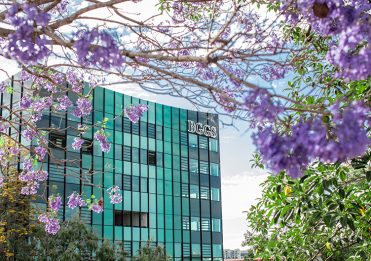Mrs Anne Ingram, Deputy Principal
John Muir, a Scottish-American naturalist, wrote this statement at the turn of the 19th century, suggesting that nature has a restorative power. It has always inspired, brought peace and provided space for reflection. Today, we live in a world that has become increasingly complex and fast paced. Our modern-day society has embraced an unrelenting momentum that energises us and drives us. It can also challenge us, and if this challenge becomes too great it can interfere with our wellbeing. When we seek respite from such an imbalance, often the best interventions are deemed to be those most technical and complex. But perhaps we have reached a point where we are seeking somewhat of a turning point, amidst the frenetic pace of this world in which we live. We are hearing the voice of challenge—challenge to this dogma of complicated interventions. Something far simpler could indeed be the solution. Reaching back to our roots and engaging with ourselves and other people in natural settings could, and should, be a part of our routine, to help us rediscover our place in the world. As our modern lives shift ever more indoors, the solution that nature can provide in fostering our health and wellbeing is becoming more urgent than ever.
For centuries, our poets and philosophers have extolled the benefits of a walk in the forest. Musical composers have drawn inspiration from the oceans, mountains and trees. We sit on golden beaches, feel the sand between our toes, gazing at the azure expanse and rolling surf, and marvel at its majesty and beauty. Florence Williams, author of The Nature Fix, investigates the science at the confluence of the environment, mood, health and creativity. She makes a compelling argument for time spent outdoors and the powers of the natural world to improve health and vitality, promote reflection, inspire innovation and strengthen our relationships. It is her view that nature serves as a welcome reprieve from the seemingly endless demands and constant stimuli of our modern life. Hers is a compelling case that suggests that time in nature can be mood-altering. It has the power to impact our biology for the better by subduing our innate stress response.
Dr Julia Baird, author of the book Phosphorescence: On awe, wonder and things that sustain you when the world goes dark, dedicates an entire chapter to the notion of ‘bathing in nature’, and the positive impact this can have on our psyches. She reflects on our deep and rightful connection to the Earth—‘a love of nature is coiled within our bones, laced in our marrow, steeped in our blood.’ Across the globe, as urban dwellers begin to outweigh country dwellers, Baird questions the unknown consequences of such a shift. With increased urbanisation and digital creep, this dislocation from the outdoors appears to be having a negative impact on wellbeing.
‘We hanker for the sight of green and blue, for the Earth of our ancestors, the sea of our origins, and the feeling on our faces of the sunlight that first nurtured life.’ (Baird, 2020)
While humans have been urbanising and moving indoors since the introduction of agriculture, it is the social and technological changes that have taken place across the past three decades that have accelerated human disconnect from the natural world. These include the proliferation of electronic communications, diminishing open space as a result of poor urban planning, increased street traffic, a waning importance of the natural world and parental fear that has been magnified by the media (Louv, 2019). Nature Deficit Disorder, first introduced in 2005 by Richard Louv, author of Last Child in the Woods, is not a medical diagnosis, rather a metaphor used to describe the human costs of alienation from nature, which include a diminished use of the senses, attention difficulties, conditions of obesity, and higher rates of emotional and physical illnesses. Research also suggests that the nature-deficit weakens ecological literacy and stewardship of the natural world. These problems are linked more broadly to what health care experts call the ‘epidemic of inactivity,’ and to a devaluing of independent play and unfettered exploration of the natural environment.
It is tantalising to consider the impacts of greenspace and nature with regard to school design and to consider the outcomes that this might have, given the well-documented impacts that nature has on psychological and physical wellbeing. Recent experimental work in school settings supports the restorative effects of contact with nature on attentional capacity and stress levels. Green outlooks from classroom windows improve concentration. Teaching outdoors or in natural areas can aid learning comprehension and retention, and has been associated with high levels of student interest (Browning and Rigolon, 2019). While the literature that may specifically connect school green space and academic performance is in its infancy, there are indications that there may be some correlation between the two (Leung et al, 2019), and this research advocates for the greening of school landscapes as a way to further support learning outcomes. Given the rich body of research linking student wellbeing with academic achievement, and the impact of nature on wellbeing, a connection between greenspace, nature contact and academic performance seems plausible.
When we take the time to consider the BGGS landscape, despite our inner-city school status, there are many opportunities for our students and staff to appreciate greenspace, from the rolling greens of Rangakarra, time spent at Marrapatta, to the Spring Hill campus, with its prolific and strategically placed gardens, and views to Victoria Park and its surrounds. Perched on top of Spring Hill, we can enjoy the green vistas in many directions, in purpose-built facilities designed with the intent of welcoming the outdoors in. In our increasingly urbanised and technology-dependent lifestyles, we must continue to challenge ourselves to rediscover this idea of nature-mindedness, to inspire our school community and our society in which we live to grow and sustain the wellbeing of all.
‘Go outside, often, sometimes in wild places. Bring friends or not. Breathe.’ (Williams, 2020)
References
Baird, J. (2020). Phosphorescence: On awe, wonder and things that sustain you when the world goes dark. HarperCollins Publishers Australia Pty Limited.
Browning, M. & Rigolon, A. (2019). School Green Space and Its Impact on Academic Performance: A Systematic Literature Review. International Journal of Environmental Research and Public Health, 16, 429; doi:10.3390/ijerph16030429
Leung, W., Tam, T., Pan, W., Wu, C., Lung, S. & Spengler, J. (2019). How is environmental greenness related to students’ academic performance in English and Mathematics? Landscape and Urban Planning, 181, 118-124. doi:http://dx.doi.org/10.1016/j.landurbplan.2018.09.02
Louv, R. (2006). Last Child in the Woods: Saving our Children from Nature-Deficit Disorder. Chapel Hill, NC: Algonquin Books of Chapel Hill.
Muir, J. (1901). Our National Parks. Read Books (2013).
Stuart-Smith, S. (2020). The Well-Gardened Mind. New York: Scribner.
Townsend,M. & Weerasuriya, R. (2010). Beyond Blue to Green: The Benefits of Contact with Nature for Mental Health and Well-Being. Deakin University, Australia.
Williams, F. (2018). The Nature Fix: Why nature Makes us Happier, Healthier and More Creative.
Wu, C., McNeely, E., Cedeno-Laurent, J., Adamkiewicz, G. & Dominici, F. (2014). Linking student performance in Massachusetts elementary schools with the “greenness” of school surroundings using remote sensing. PLOS ONE, 9(10). Doi:http//dx.doi.org/10.1372/journal.pone.0108548



